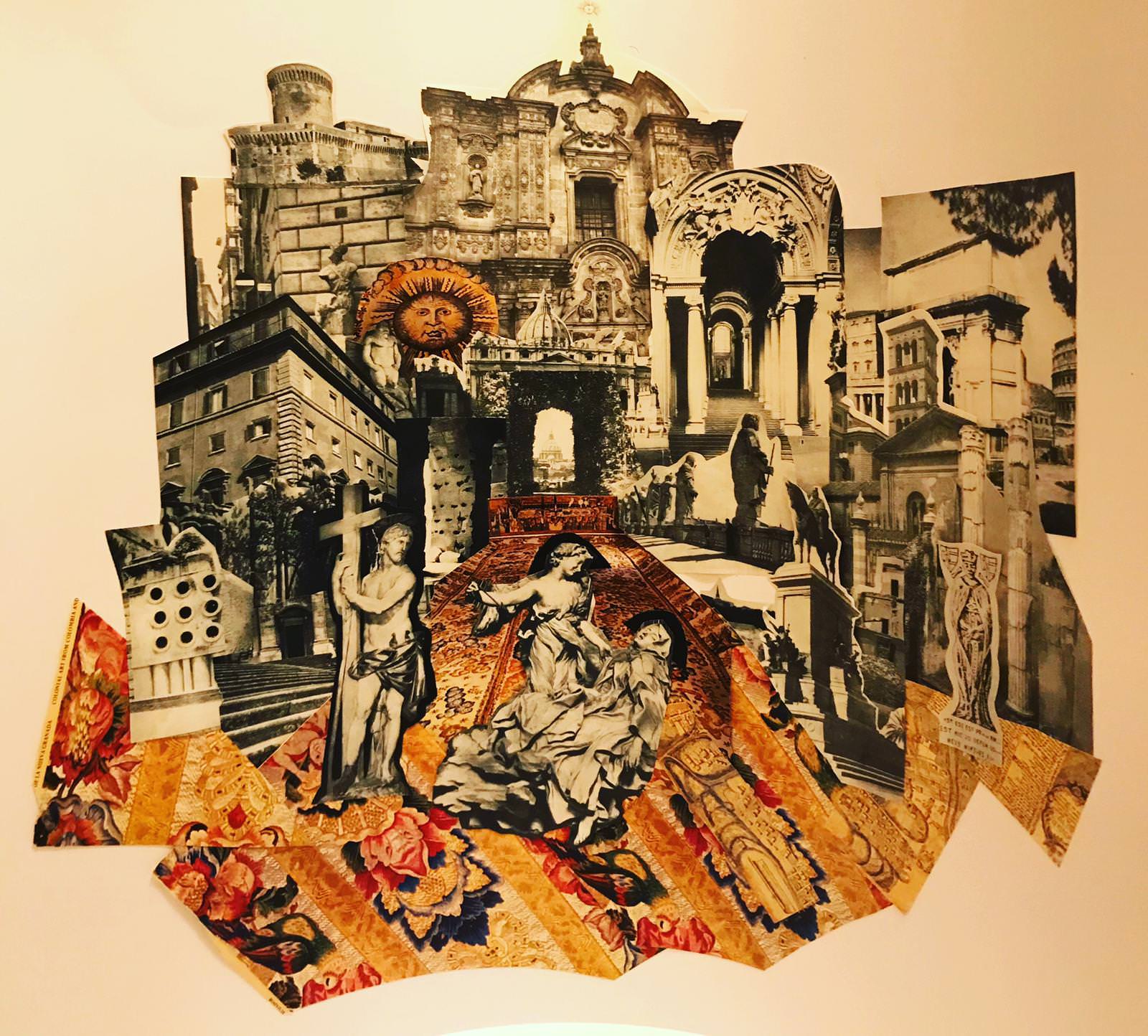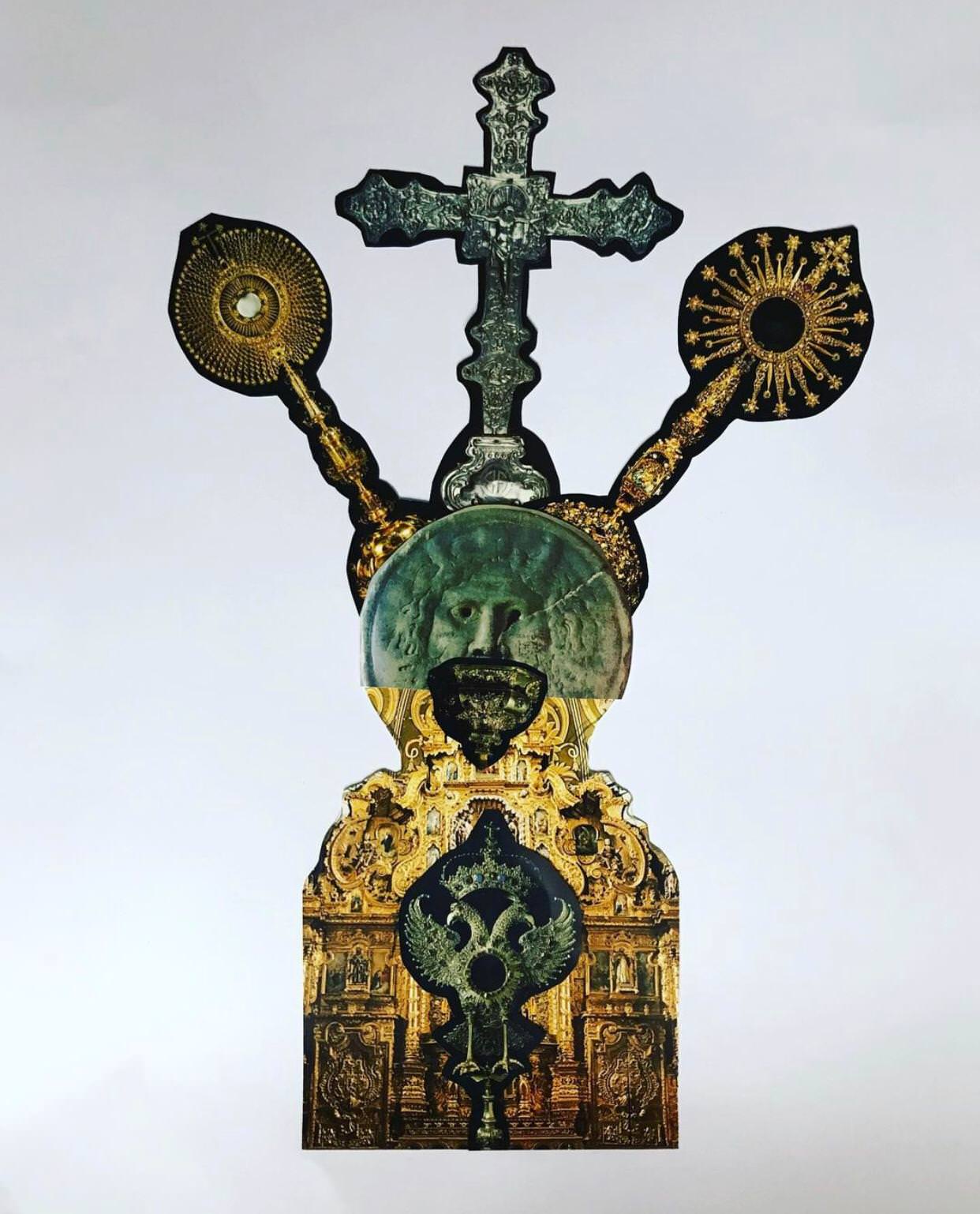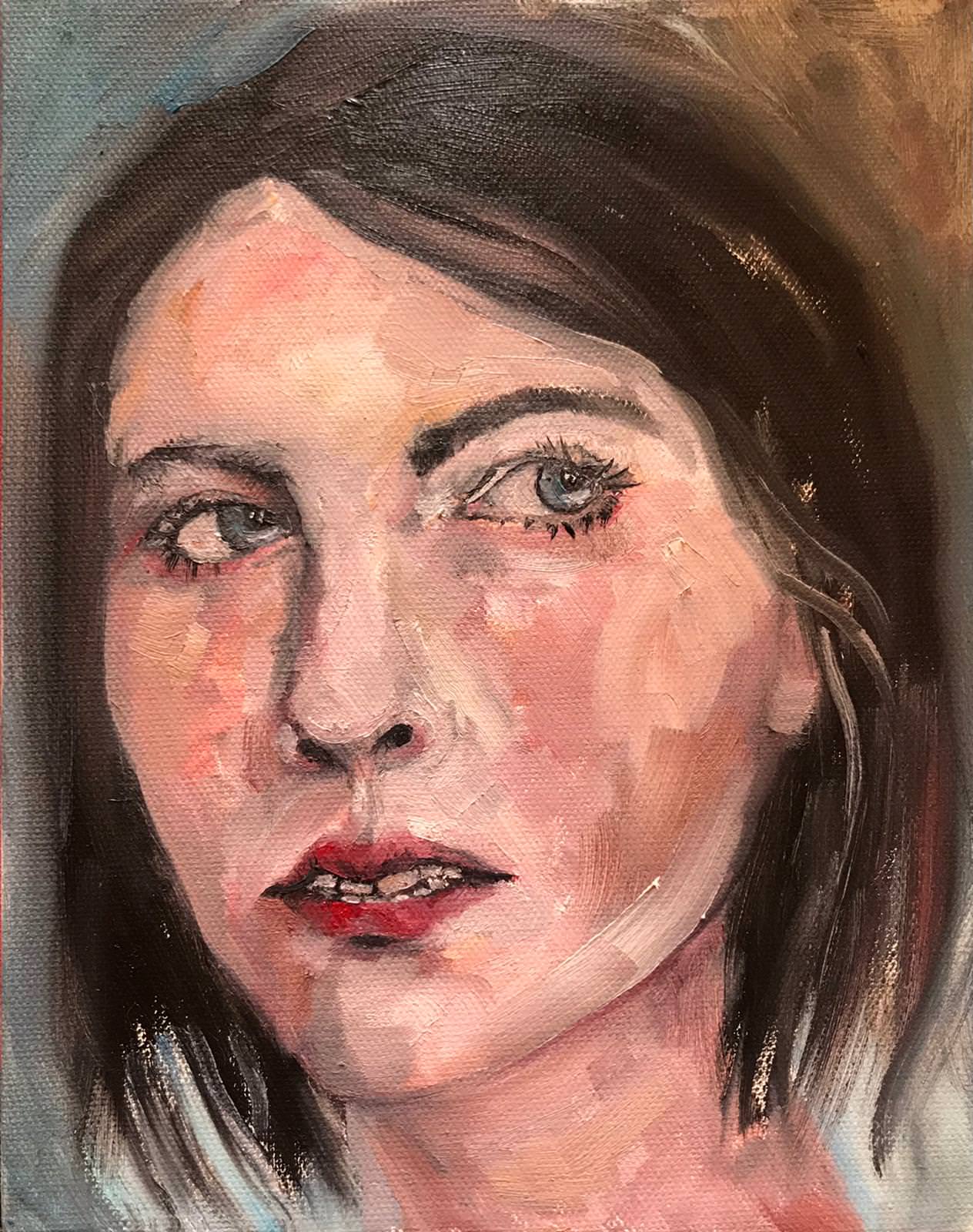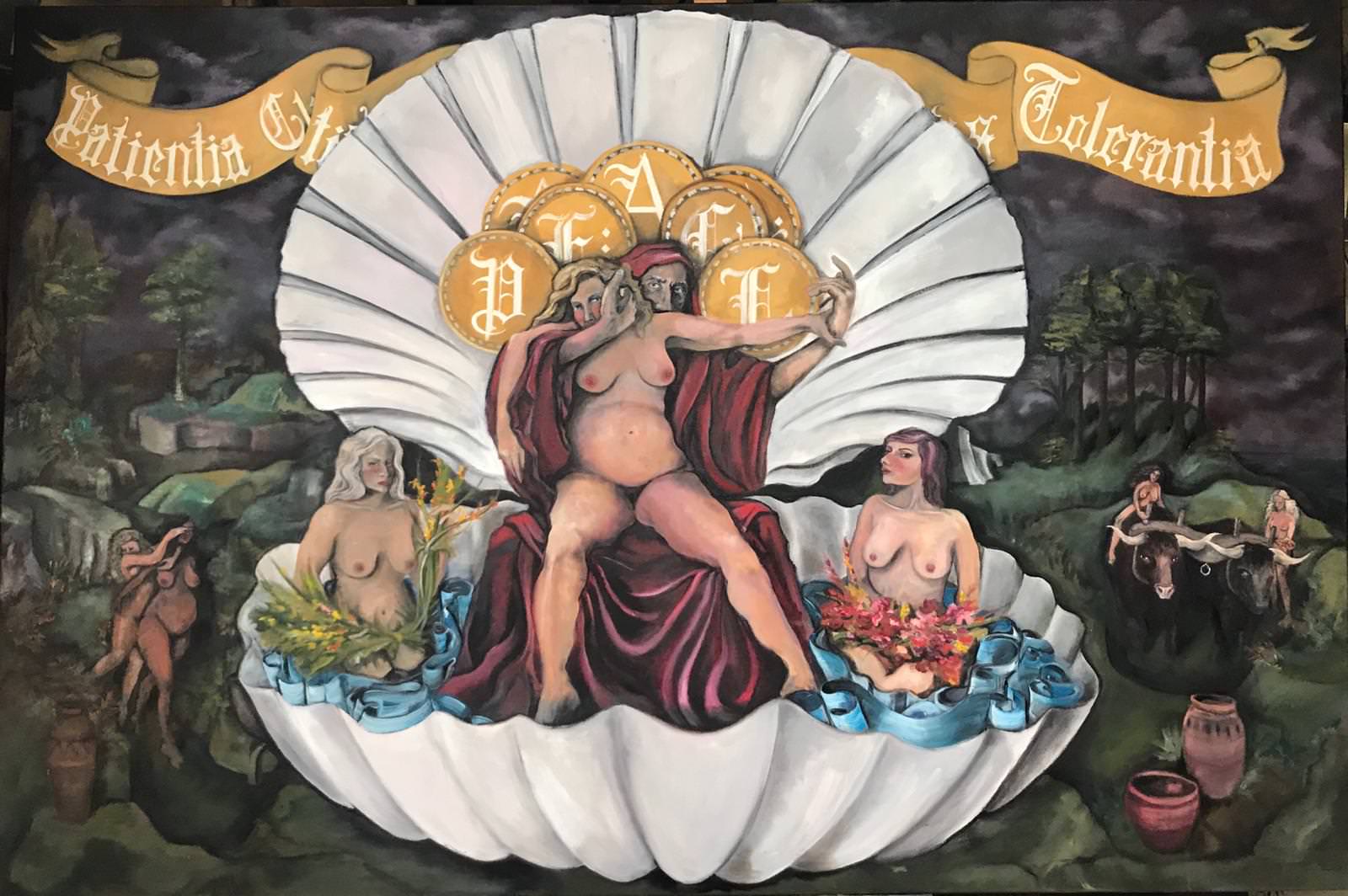I talked to the talented English painter Marie-Louise Plum, who told me the story of his incredible artistic trajectory and made several reflections about the meaning of art and the effects it can have on people's lives.
We also address other issues, as the possibility of living professionally as in painting and also… heresy and witchcraft!
Check!

1 – Marie, Please, first, tell us a little about your life. Where did you born? Where do you live now and how did you become interested in the artistic universe??
Although I currently live in London, city where I spent the last twenty years, which represents more than half of my life, I was born in Bedford, which is about 50 miles from where I am now, and I grew up in a semi-rural village called Clapham. I spent a lot of time at the Italian side of my family, which is the part of the maternal side, especially with my grandmother, that was a huge influence for me. She was a painter and encouraged me from a young age to pursue creative activities. Maybe this was really taken seriously by me, since I wasn’t a very studious student and spent most of the classes secretly caricaturing the rest of my classmates, instead of focusing on math, geography or science.
I only started painting ten years ago and before that I was an illustrator, drawing being my main obsession since childhood. However, I think this change had to do with a very stubborn attitude of not taking anyone's advice, drop out of school, dropping out of college and not attending university. If I had enjoyed school and education, and opened the door to other means and practices, maybe I had abandoned the boat to become a painter a long time ago.
2 - What are your main influences? I would like to know what inspires you not only in art, but also outside of it.
Education seemed to approach me after my twenties. I became obsessed with history, in the academic sense, as I’ve always been obsessed with aesthetics, for the memories of history and for capturing certain moments of time. To ramble, I mean I loved stores that sold scrap metal, antique shops, museums and also loved to find ‘old things’. I've always collected things – I collected moments in time – holding fragments of seemingly insignificant occasions or fleeting experiences. About fifteen years ago, I started collecting all these collected fragments of life and leaving them in museum windows – in no specific order – just putting them all in there, sealing your powers, like a capsule of times gone by. So, when I say that I am now obsessed with history in a sense “academic”, I simply want to say that I am interested in learning facts, numbers, "Where", "because", unveil a mosaic of human patchwork and, particularly, I like social history, especially from Britain, from the 15th century onwards. Therefore, I read history books for pleasure and inspiration. I spend a lot of time (as possible due to Covid's situation) on the shore of the River Thames. I also spend a lot of time in cemeteries.
All the usual influences that other people have, I also have… music, art, cinema, literature. To cover it all without boring the reader with details, I am naturally drawn to darkness, for or mysterious, for the fickle and the atypical. Oh, I could also add that I’m currently working on all of Dickens’s novels and I love a little melodrama in music, especially the complaints of Barbara Strozzi.
3 - I realize that you paint a lot of human bodies. They have some special meaning for you?
Navigating the tangled web of self-expression. My starting point, years ago, it was the shock and revelation of an unexplained bomb. You can see that in my first paintings, because they are somewhat primitive and show me clearly how to deal with the transition from illustrator, used to drawing by hand, to try to practice a more pictorial style, and failing. I started with topics that interested me - such as the human condition, the sense of identity, to mental torture, the suspicion, isolationism, the internal conflict – but I didn't have a sophisticated way of expressing those interests, except to make the subject limitless and shocking, and often, with naked figures, being that, at first, painted almost always totally hairless. Grotesque. As my practice developed and I became more inquiring about myself, what I mean, in relation to how to express something and why to express that something, my paintings have become less open and more sensitive to the situation I'm trying to convey. Bodies, the people who inhabit them, not the body itself, but the expression, a pose, composition and vignette. I slowly removed my drawing habits, that at first could be seen in my paintings, and my painting style, in this way, developed. Ten years later, I finally found out that you don’t need to paint something graphic to convey a moment of punishment for the lived experience, and not everything needs to be outlined in a dark color, but in shades, highlights and shadows of it for you. Finally, I like to paint pictures and their language. Although I don't want to alarm you, I just started my first significant landscape of the mysterious Thames River…
4 - Do you usually think of something specific before you start painting?? You choose a theme beforehand, for example? Or you just paint by intuition, without planning anything?
I used to always do the last painting, but with more success. Or, then, I can just have a general feeling, or germ of an idea, and then it ends up in a final result. A successful example of this would be two large-scale painting performances, 12 Meses e Suburban English Magick (which is a bigger and continuous project, that can be seen in the IG in @suburbanenglishmagick).
I was hired on two occasions to paint the interior of:
(i)) a large room that today is a courtroom (if they had seen what used to decorate their walls!), and
ii): a shed, the CCCA in Coventry, that belonged to the artist Bob and Roberta Smith, and it was actually donated by him to the city. On both occasions, I wrote and recorded a prose poem with an audio track base found, that I mended from ‘field recordings’ that I captured and painted, while listening to the track. It was a very intuitive experience, hypnotic, trancelike, based on an existing idea, whose ‘flow’ was only interrupted when a member of the questioning public asked me, with reason, exactly what the hell i thought i was doing.
Nowadays it's a different story. I consider what the hell am I doing!
5 - What kind of effect do you think people feel when they look at your artistic productions?
I hope they have a sense of recognition, that they already experience a similar sensation or experience a sense of already seen with their own experiences or, then, a kind of voyeurism through a window, or even the sensation of capturing an instant scene of a passing moment and, then, they think: “Yes, I know that ”.
6 - What do you feel when you are painting?
I used to feel a lot of frustration and now I feel meditative. I feel calm in a restless world. The world", with a capital M, for, and I am immersed in my own world.
Sign up to receive Event News
and the Universe of Arts first!
7 - How do you define art? And how positive it can be in a person's life?
I assume I can't skip this question and answer it like this: I really do not know. All of the items above that we talked about go some way to my definition, creating a call and answer, even a silent response. The art it's a language. I feel overwhelmed, in the good sense, when I visit certain galleries, because I can go crazy out of admiration and some sensation, but this is often specific, and mainly it does not extend beyond the years 1940. I don't know if that kind of art, of that period mentioned, is equal to this art, that is happening in 2021. But I can say that the art is adverse, appears in art groups, parades as individual pieces, it's a feeling, a skill, a stir, a powerful object and nothing, just a word, it's decorative, but it is not, is trained and skillful, carved and polished, it is provocative and mocking and requires no effort. As to how positive it can be, good, I know it can be very positive, but I don't think it should be exclusively positive, or there would be no sense. We can't always be happy, we can? Maybe I should have skipped this question.
8 - It is possible to live on art nowadays? We can make it a job? What is the biggest challenge of a artist independent in our times?
There are two roads that I can distinguish. The first: study, know your trade, be very good at it, promote your product, be a brand, meet the right people, make the right sounds, do the right thing and make money. The second: have absolutely no idea what you’re doing, but keep doing, remain unpopular and pray for Vincent.
9 - Could you tell us a little about your series of paintings of women in history that were executed by supposed witchcraft practices? I think this is, specifically, a really cool theme that you work with!
It's an ongoing project, called Heretic. It is ambitious and maybe a little self-punishing. I decided, at the beginning of the lockdown of 2020, paint a portrait of every woman from the 1st century AD to 1727, named martyr, heretic accused of being a witch. Using the ‘Book of Martyrs’ of John Foxe as a starting point, I worked on a big screen, that took too long to be done, of the seven holy women appointed in the Eucharist, subverting their destinations. At the same time, I was researching women from the British Isles and the Channel Islands who were accused of witchcraft and painting portraits of these women. I am interested in the way in which they can be used as tools, from the lowest scale of your local community, as scapegoats when there needs to be a, and to clean up the ‘undesirables’, to a greater scale of political and social unrest, like poverty, lack of education and the national ‘witch hunt initiative’ to divert the population, for example, of your monarch, who was having a paranoid breakdown, as the country was disintegrating, in times of epidemic – women were being eliminated to bring public joy, to lift the spirits and see if the ruling classes were in the case with… at least something.
Regarding martyrs and heretics, I’m interested in the fast changing background of the ‘new’ it's old’ religion and the ever-changing environment in Britain for centuries 15-17, and also those who were executed for practicing a ‘wrong religion’ that, indeed, era, Let's say, the right religion a few weeks ago. If you consider the arch of martyrs, heretics and witches, realizes that there were people executed for believing in something and also for refusing to portray, or, then, for not believing in something that was attributed to them, and deny that they had anything to do with it – therefore, there would be condemnation if “you did it” and also if “you didn't”.
Looking at the modern day, and I'm still trying to understand what makes me curious here, I also find it fascinating that these women, often reported as unpleasant characters, or elderly and infirm people who could be eliminated, most likely weren't witches, but are seen primarily as honored by practicing contemporary wizards and academics with an interest in folklore and witchcraft. The duality of women slapped with a witchcraft ticket, not really being witches, but mainly being remembered exclusively by tourists of the folklore and these aforementioned modern day wizards, makes my mind a little confused. This does not mean that it is a negative thing, only “one thing”. Regarding what I'm painting, I can say that I often normalize the context in which I portray ‘witches’, for example, showing them in their youth, within their communities, with friends, Kids, sometimes with your ‘family’ simply as pets, and not as demonic messengers of the devil. Portrait and focus on women and, although I am not focusing on them, many, many men – were treated in the most barbaric and terrible way, often from sudden decisions made by powerful figures who were playing with people to increase their popularity and save their own skin. I’m also examining the legacy of executed women, like Perotine Massey and her unborn child, part of the Martyrs of Guernsey, who were not only murdered, but their legacy was shattered by the warrior Thomas Harding, a Catholic priest, and also the aforementioned John Foxe, who accused each other of using Perotine to promote their own interests. It is a vast project that goes far, which I'm taking a short break at the moment, since the weight of the subject tends to last after months and months of digestion of horror stories. Although I have focused on historical cases and will continue my mission to paint dead women for a long time, I am perfectly aware of the parallels that can be drawn between this issue and the mistreatment and abuse of women and girls in modern days, that occur in various parts of the world – no UK, including – for similar reasons, and I'm always sad to see, sometimes, how little we learn from our past.
.
.
JULIANA VANNUCCHI
Sorocaba – São Paulo
Facebook Profile | Facebook Fan Page
Website Philosophical Collection
E-mail: ju.vannucchi@hotmail.com
Group on Facebook | Instagram
LinkedIn | Facebook | Twitter











